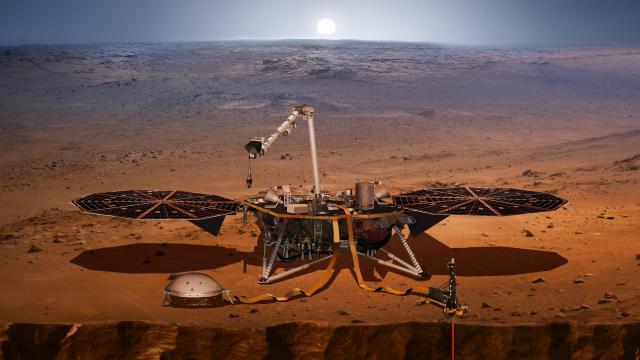Researchers studying seismic wave data from NASA’s InSight Lander have reported the planet’s largest ‘marsquakes’ yet, at magnitudes of 4.2 and 4.1. According to a NASA release, the larger quake was five times as energetic as the previous record-holder, a magnitude 3.7 event detected in 2019.
The tremors happened August 25, 2021 and September 18, 2021. Now, a report from the lander’s Marsquake Service published in the journal The Seismic Record scrutinizes the two events and offers details about their locations and intensity.
The marsquakes happened in what’s called the ‘core shadow zone,’ a part of the planet where some types of seismic waves cannot travel directly; bent by the planet’s core, the waves reflect off other surfaces before arriving at InSight’s seismometer.
The lander’s seismometer was deployed in December 2018 and since then has detected over 1,000 events. The data has given scientists a portrait of the Martian interior, including details about its depth and structure.
“Recording events within the core shadow zone is a real steppingstone for our understanding of Mars,” said Savas Ceylan, a geophysicist at ETH Zürich and co-author of the recent paper, in a Seismological Society of America release. “Being within the core shadow, the energy traverses parts of Mars we have never been able to seismologically sample before.”
The magnitude 4.2 quake occurred in the Valles Marineris, a large canyon network on Mars about 8,497 km from InSight. The event probably originated at greater depths within the planet than the magnitude 4.1 quake, the study authors said. But the magnitude 4.1 quake is not to be overlooked — it lasted for 94 minutes, the longest seismic event yet recorded on the Red Planet.
InSight is providing new clues about the Martian interior in spite of its disappointing beginning. Last January, NASA officially gave up on the Mole instrument, a heat probe that was supposed to dig into the surface and take the planet’s temperature (it couldn’t get purchase in the cloddy soil).
More recently, dust coating the spacecraft’s solar panels has threatened its ability to, uh, stay alive, but for now the lander is still hanging in there.
